The First 10 Days of Training (Starting Off On The Right Paw)
So, we've got a new puppy... now what?
Let’s set the scene, shall we?
It’s December 2020, the last few weeks of a year we will all never forget (though I’m sure many wish they could). Nearly everyone and their uncle has a new “pandemic fur kid” it seems, and our household has just joined the fray. Now, we are no strangers to fur kids by any means (come on, we founded a company called PetHub for goodness sakes!), but we haven’t been “puppy parents” for nearly 10 years, so we are frankly a bit rusty. And, unlike previous puppy-dom times in our home, we are no longer "carefree, got lots o’free time DINKs (dual-income no kids)" -- we have a HUMAN kiddo, too (and a TODDLER one for that matter!) and our lives are kinda nutty busy. I think it’s important to understand our thought process on adding to the family:
“Hey, honey, I have an idea. Ya know what would make all the chaos of stay-at-home-run-your-business-in-a-new-house-still-under-renovation-with-a-toddler-during-a-pandemic even BETTER?? Let’s get a Boston Terrier puppy!”
“Oooh...capital idea, babe! Oh! Oh! I have an even better notion! Let’s do it right before Christmas!”
“BOOM! Best. Idea. EVAH!”
Seriously, that’s kinda how it went down. We laughed with gleeful anticipation as we whimpered in terror. We knew that the KEY to making this insanity work was going to be training the little pupper (and the little human) the right way from the git-go (someday soon, I’ll write a post about training human lil buggers for new pets). I knew we needed help, so I called in my good friend Robin Bennett, aka, Dog Guru.
Help Wanted: Puppy Trainer, Please!
Robin has helped me tremendously in the past and she is a well-respected professional dog trainer & mentor (check out her site Dog Gurus which is all about training dog trainers!). For people like me, Robin has an incredible product -- Raising Your Puppy (Your Puppy’s First 6 Months) -- I’m gonna call it RYP for short from this point on FWIW.
RYP is a complete online guide (perfect for the pandemic stay-at-home world we live in right now) built in “Lessons” for each week. Here’s what I love about this course:
- Variety of content types -- I’m not a “one size fits all” kinda gal and my attention lags when I’m faced with any single content type for too long -- vids, check lists, short how-to lessons, games
- Short, bite sized chunks of content! Again -- I’m as bad as a dog with a SQUIRREL! distratraction disorder -- and content that is KISS content (Keep It Simple (for) Stupid) is my cup of tea
- The “please hold my hand and tell me exactly what to do and when” aspect of this program has great appeal to me -- and I get green check marks when I finish! (I’ve always been a goal-driven person so check-lists and instant approval when I finish are big motivators for me)
- I can do it on my time/pace. My usual “alone” time is around 5:30 am (not kidding) and then, if I’m lucky, that short “breather” just after I finish work and before the kidlet wakes up from his afternoon nap. There are online courses out there that require you “meet” in Zooms at required times, or sit through hour long videos -- neither of which would work for me and my toddler-challenged schedule. The RYP online course remembers where you left off -- and no judgements! Woohoo!
Miss Hedy Pawmarr will have me (and by extension, the rest of our family) not only taking this course and doing all the RYP “lessons”, but will ALSO benefit from some exclusive time with Robin Benett and her expertise in the form of a FB live video series (which, of course, you can watch at any time) on the PetHub Facebook page. Yes, HP is going to be one spoiled, but well trained pup when all of this is said and done!
Lesson 1: Let's get the paw-ty started!
Now, it’s important to note that training your puppy starts BEFORE THEY EVER COME HOME. RYP’s “Lesson 1” guide not only has a few short vids about the prep needed for you and your home, it also provides you with a e-book version of Ian Dunbar’s “Before You Get Your Puppy” (check out this free version) which is a bit long, frankly, but a critical read. If you have never had a puppy (or dog) before, it is ABSOLUTELY required reading. For us, we’ve had dogs in and out of our lives forever, and there were definitely sections of the e-book that we already knew, but a little refresher never hurt anyone.
So, using the RYP and Dunbar book’s advice, we prepped our space, secured supplies and mentally prepared ourselves for the tasks ahead...and prayed we were ready for the impending chaos. (Narrator: “They were, in fact, NOT adequately ready for the chaos…”).
Note: there are product recommendations below. We pulled together an Amazon storefront called "Starting Puppy Training Early" that has as many products that we could round up for you to quickly find.
Lesson 2 (Week 1 At Home): Training Priorities
- Acclimate Hedy to her crate
- Start housetraining
- Start teaching:
- Her name
- To sit
- To not nip (for what it’s worth -- this is NOT part of the RYP’s first week outline, but it was a critical need for us, which I’ll dig into more below)
- Begin socialization
Love the crate you're in
Personally, I am a big fan of using a crate for dogs. It’s not a cage or a jail. It becomes their place, their cave, their “I just wanna be alone” safe spot. And it is critical (in my and many trainers’ opinions) in quickly getting a pup housetrained.
We had an old Petmate kennel in the garage that was just the right size, but we purchased a new crate mat that perfectly fits the Pet Taxi and put the blanket her breeder made for her in the crate, as well as a few small chew toys to make it special for her. On the road trip home, she was kept safe and secure in the crate, and about 15 minutes in, was gnawing in puppy bliss on her new little Kong.
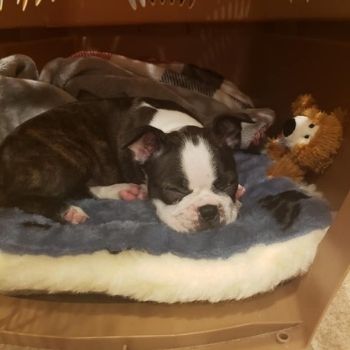
Robin has a great video on acclimating the puppy to want to go into the crate as part of the RYP course, but frankly, we didn’t need it for Hedy. By the time she got home, she was happy as a clam snuggling in the crate with her blankie and her chew toys. That said, we always make sure there are some familiar and appealing things in her crate (chew toys, food dispenser toys, and her blankie).
Note: we don’t feed her on a regular schedule, but, taking our cue from Ian Dunbar’s advice, we have kibble filled toys (she starts each day with her daily allotment measured out in them) in her crate and puppy pen and she “hunts and grazes” on her own schedule.
The smallness of the kennel (and the convenient handle) means that we can take her crate into every space in the house (and we do). She’s in the crate often, frankly, and we’ve used it as a training tool, too, in the following ways:
- During our meal times, she’s in the crate with a kibble-filled toy. She’s in the same room as us, but not at our feet, scrounging for dropped morsels (a precursor to begging behavior), or worse, potentially getting into something she shouldn’t or piddling while we are focused on eating our meals.
- When she gets really sassy (see the section about nipping below)
- Though sometimes we let her nap on our laps or in a bed at our feet, more often than not, we place her in her crate for nap time. It makes it much easier for us to manage potty breaks post nap (and for us to focus on our work).
- And, of course, at night, she’s in her crate, right next to me on the floor near the bed. The first few nights, there was a wee bit of crying (her, not me). Honestly though, she’s been amazing with acclimating and after the first 3 nights, zero crying. Even better, on night 6, she slept for 6 straight hours. By night 8...I woke up before she did after a blissful 7.5 hours! Big cheers for sleeping through the night! It took my human son almost 10 months to master that one!!
A quick word about what KIND of crate to use. Truly -- it’s up to you and what is best for your pup -- plastic, wire, cloth sided -- they can all work well (breed and personality dependent, of course).
I mentioned that we liked how portable the small kennel we are using is (we started off with an old “Pet Taxi” plastic kennel -- and I mean OLD...I think it is at least 15 years old and still in pretty good shape, which says a lot for Petmate's kennel quality) and because it’s what we had and it was a good size for her, it works for our needs to start.
As far as size -- the dog needs to be able to stand up, turn around and lay down/stretch out comfortably -- and not much more than that. If you have a pup that will grow into a BIG dog and you want to have one crate for life, there are ways you can limit the space inside the kennel (Robin outlines how to do that in a great RYP video).
Now, full disclosure, a Christmas present to myself and Hedy (yay for unexpected Christmas fun money in my stocking!) is a brand new super coolio Revolv crate from Diggs -- and I’ll review it after it arrives. I’ve seen it demoed at trade shows and I cannot wait to try it! When we get her new crate, I’m sure we’ll go back to the RYP vid for pointers on transitioning her to her new “diggs.” But that is literally a story for another day…
Housetraining
I think now is a good time to really spell something out. There is ZERO cause to discipline or punish a puppy that pees or poos in your house. No, they aren’t having an “accident” -- they are doing exactly what their bodies NEED to do and they have yet to learn that outside is where to do it.
By swatting or yelling at them when they pop a squat inside, you are just scaring them and reinforcing that they need to hide the behavior, rather than helping them learn the way you really want them to do it. Dunbar says that if your puppy eliminates in the house, you need to roll up a newspaper and whap yourself on the head -- because it’s 100% YOUR FAULT they did it. In fact, MOST mistakes & misbehavior from pups are the human’s fault and discipline, punishment and “domination” based training is never warranted in my book. (okay, stepping off of soap box…).
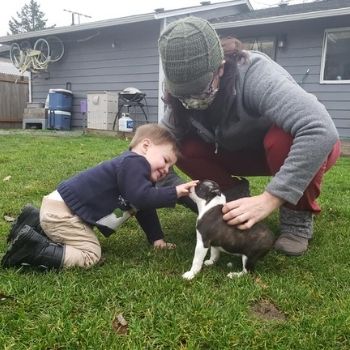
Dunbar suggests taking the puppy out every hour on the hour. Sorry, dude, that just wasn’t working for us. RYP maps out what a typical “schedule” is for an average puppy (spoiler alert -- it’s a LOT) and Hedy Pawmarr DOES require very frequent trips outside. Though we personally didn’t do “every hour on the hour”, we do go out at least 8 times during waking hours and 3x overnight the first few nights. Here is the general “rules” we’re using for taking Hedy out:
- After every nap (even little short ones, if she stirred from sleep, we scoop her up and take her outside). In all fairness, this is where we diverged from Dunbar’s “every hour on the hour” thing most -- because some naps are longer than others (2 - 3 hours!) and some were barely 20 minutes. We found the nap rule better for us than an hourly outing.
- After every play or training session (even if she “just” went before the session, we knew that her bowels and bladder were gonna be triggered after heavy physical or mental activity)
- After every time she eats (which, as stated above, isn’t on a set schedule, so that requires paying attention). Even if she just got inside 15 minutes ago, something in those little intestines is triggered when food hits her tummy, and poo is likely forthcoming soon!
Once outside (in the cold, snow and ice, mind you), we help her find a relatively sheltered spot (we even cleared some snow so she’d have some grass), and the second she squatted to pee, we’d cheer and squeal, “Good ‘take a break’!” And when she sniffed out the perfect spot to drop a poo bomb, again, we’d squeal and celebrate, “Good ‘do your business’!” Yes, she looked at us quizzically at first. And yes, on two occasions, neighbors watched our poo celebration dances, laughed at us, and then called out congratulations on the new addition to the family (everyone who’s had a puppy gets the whole celebration of outside potty scene).
FWIW, “Take a break” and “Do your business” are the phrases we've used with all of our dogs, and even some of our extended family uses the phrases with their pups -- so we decided to stick with the tradition. To be clear, there is no “magic” phrase for outdoor potty verbal cues -- just that you pick phrases that you stick with for the rest of the pup’s life.
One thing that REALLY helped me was a 30/3/3 outline:
- She’s gonna pee within 30 seconds of hitting the ground. If she doesn’t, either she truly doesn’t need to go (doubtful if we were following all the other guidelines) or there is something wrong (she’s scared, too cold, feet wet, etc.) and I need to adjust something for her (move her to a dryer/warmer/more sheltered spot, encourage and comfort her, or set a pee pad on the ground -- only had to do this once)
- It can take up to 3 minutes for her need to poo to trigger -- I have to be patient enough to give her that time (which trust me, in 30 degree middle-of-the-night potty breaks, that 3 minutes can be torture!)
- I want to see her “pop a squat” for peeing and/or pooing at least 3 times per outside session -- once is not enough...there is still more in that little body, I guarantee it!
The first few days, we didn’t do treats when doing outside potty breaks, mostly because we forgot to bring them with us. But now (especially after we’ve had a few “oops” episodes on the carpet), we bring out the most delicious treats EVER...freeze dried beef liver...to shower her with after she’s had a successful outdoor potty break. The hope, of course, is that Hedy P. starts to make the connection that she never gets treats when she “goes” inside, but when she does her business or takes a break outside...it’s a full on party with favors!
When we made a mistake and Hedy’s relieved herself indoors, we whapped ourselves on the head and noted where we’d missed a cue. On two occasions, we actually “caught” her just as she was squatting and scooped her up with an “outside, outside, outside!” Hopefully we didn’t just scare the crap outta her (um, literally once, as a nugget dropped as we were rushing out the door), but we never scolded her...ever. And when there was an oops, we used one of our very favorite company’s products to clean it up -- Unique Pet Care -- they truly do “tackle tinkle” and I cannot recommend their sprays and cleaners enough.
Also, for the record, Hedy does NOT have free roam of the house yet. She is relegated to whatever room we are in and is bound by baby gates/pens and/or her crate if we cannot be focused on her. She is NEVER left alone outside of her crate/puppy pen. She’s got razors for teeth and is chewing on everything. It also seems like the only times she has “oops” indoor pottying...it’s when we don’t have eyes directly on her. She’s gotta learn to earn her freedom to roam.
Lessons will be repeated until they are learned
Ah...actual “training”... so, about that. It was SUCH a crazy week with a new puppy, Christmas with a toddler AND recovering from a hand surgery days before (oh, did I forget to mention my dominant hand was wrapped in a surgical bandage and essentially useless for the next few weeks on top of all the other chaos??), I honestly dropped the ball on focused training sessions until about day 6 (when I literally thought, “Oh crap! What the heck am I supposed to be teaching her to do this week??).
Here’s how it all went down:
What’s in a name?
Learning their name is a key “first” for a new puppy. RYP recommends not using the pup’s name much other than in concentrated training sessions designed to “teach” them their name and use it to really get their attention.
Full disclosure: we absolutely FAILED at this. We threw her name around like Santa throwing candy out at a pre-Covid parade. When I realized the “don't use Hedy’s name” horse was out of the barn, I tried to do damage control with training sessions as shown on the RYP vids (essentially saying her name and then using a clicker/treat when she looks at me). But the “success” of this particular training is hit and miss at best. We will continue next week, but this week, it’s RYP Training Success 0 - Typical 2020 Life 1
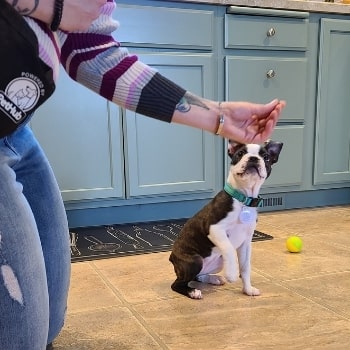
Hedy doesn’t give a SIT
Actually, that’s not totally true...we did have success with the whole “sit” training (but how can I resist such a perfect intro heading I ask you??).
RYP vids outline the classic “lift the treat” above puppy’s head method with clicker and then treat when her butt hits the floor. It took her about 10 seconds to “get” it and now, she sits CONSTANTLY when she thinks we want something from her.
As I write this, we are technically at day 10 and in the second week, but even during the first 2 days of training that actually happened during Lesson 2 (Week 1), she was already correlating the word “sit” with bum rests. So...we’re even! RYP Training Success 1 - Typical 2020 Life 1 - yay, Team Hedy!
Nipping the nip in the bud
Training a dog to be “soft mouthed” is critical. That said, it’s not something that RYP outlined in the training course during Lesson 2 (Week 1 at home) or at all in the next lessons I’ve sneaked peeks on.
We decided, though, that this needed to be a big focus for us for so many reasons. First and foremost, we have a toddler, and his safety is paramount, and we want him to have a great relationship with Hedy and dogs in general. Second, we learned from our breeder (and our immediate experience) that Hedy is a mouthy little thing. She’s mega sassy, too, and uber confident. All of this is all well and good, and you can have a mouthy, confident dog that doesn’t bite, but only by training them to be soft-mouthed.
Here’s what we’ve got going now to help her (and us) learn to use her mouth gently and safely:
- When she does nip/connect painfully with her teeth, we give a sharp “yip” or “ow!” and jerk away from her dramatically. Essentially, we are trying to mimic what her littermates/mamma dog would do. It’s frankly working well so far as her usual reaction is to nuzzle us and start licking.
- When she gets really riled up (usually during a play session where she is trying to dominate everything -- she wants to WIN, dang it!), SUPER sassy and sounds like Cujo (frankly, I think this is a Boston Terrier thing because I’ve known many that sound exactly like this, but they are truly playing -- but it can be really overwhelming for a toddler and she’s definitely “wound up” and unpredictable when she acts this way).
So without any scolding, we gently scoop her up and put her in the crate with a chew toy and essentially ignore her for a few minutes. When she settles down, we let her out (usually by way of an outside potty break). If she gets nippy/sassy again, we gently put her back in the crate. We told our son it’s her version of “crib time” (essentially a toddler time out), and he TOTALLY gets that concept! - Chew toys have taken over our home. I’m totally serious. We started with 4 toys, but by day 3, we purchased about a dozen more and every room has at least one emergency toy for popping in her mouth when she starts to chew on us (or our shoes/clothing).
I'll likely do an entire post (and FB Live with Robin) on this subject, but it's going to be one of the first challenges we hope to conquer.
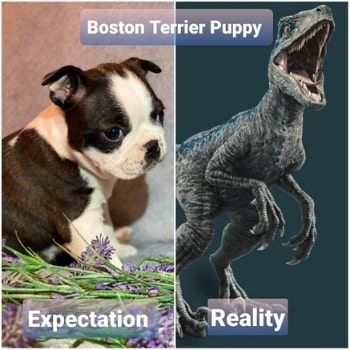
Becoming a social butterfly during a time of social distancing
One of my favorite parts of the RYP course are these great printable checklists for things like socialization. In “normal” times, socializing a puppy can be challenging, but in our current Covid lock-down world, it’s darn near impossible. Compounding it even further...it’s colder than the North Pole here for the last few weeks and going for walks to see people, other dogs and the “stuff” of the real world that a puppy needs to see and get comfortable with is simply out of the question until it warms up a bit.
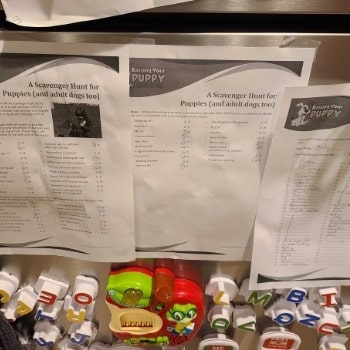
That said, we’re doing our best, and up to 26 new people met in the first week with us! This weekend, we have a few outings planned, too, to get some of the Puppy Scavenger Hunt items checked off. Hopefully the weather will cooperate! I suppose one of the things that worries me the most is having a dog that is not good with other people or dogs. In the upcoming weeks, that’s going to be another topic of discussion with Robin for our Facebook Live sessions.
Preview of next week…”Lesson 3” -- more of the same with housetraining, learning her name and socializing; and we’re going to add in puppy handling (ooh, more cuddle opportunities!!) and “down”. See you soon!
Bringing Hedy Home chronicles the journey of bringing a new puppy into your life. In this series, PetHub's CEO, Lorien, shares all of the joys (and terrors) that come with sharing your home with a puppy and provides some of the lessons she has learned in her lifetime of being a pet parent. This is the 4th article in the series and was written by Lorien Clemens on December 29, 2020.


